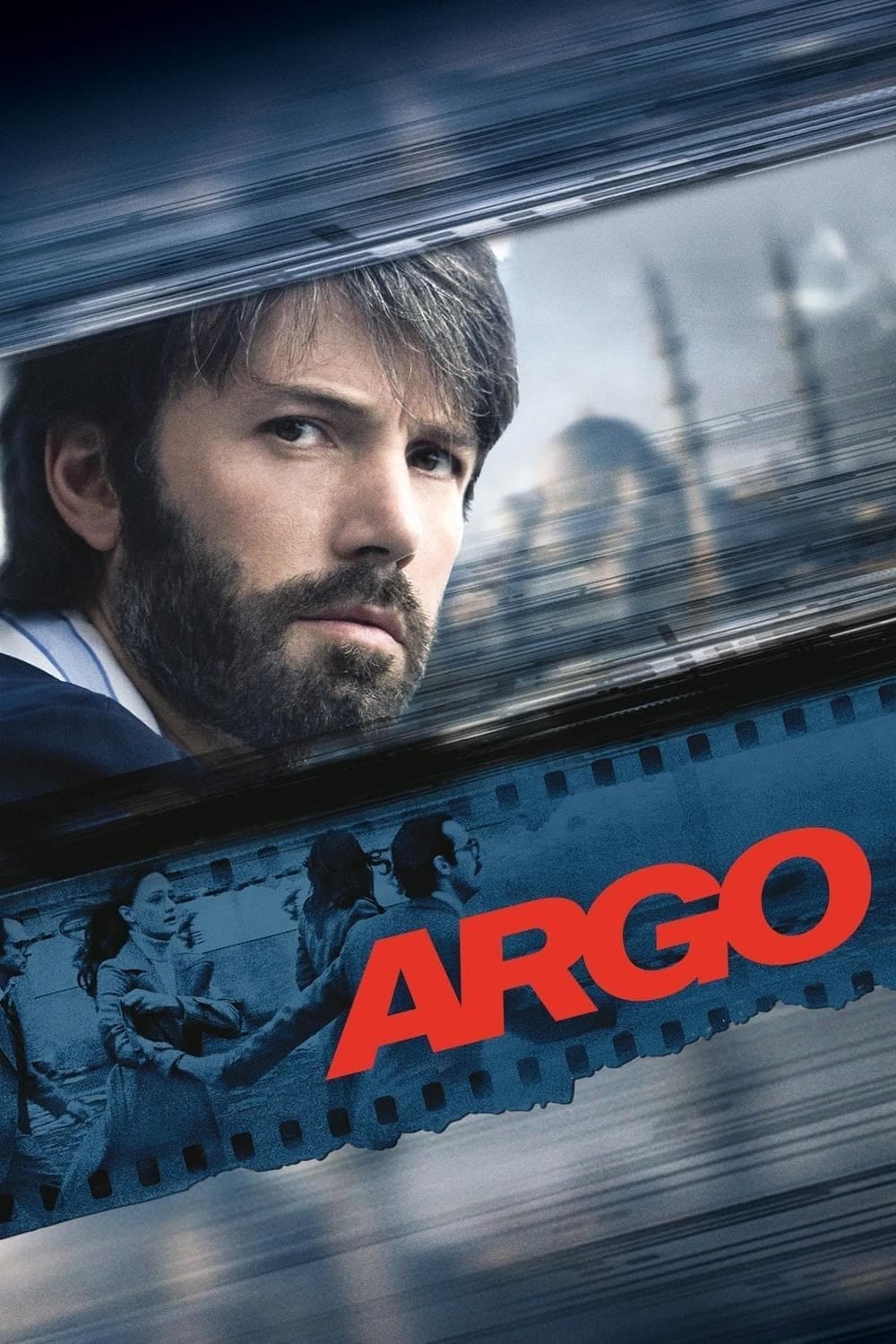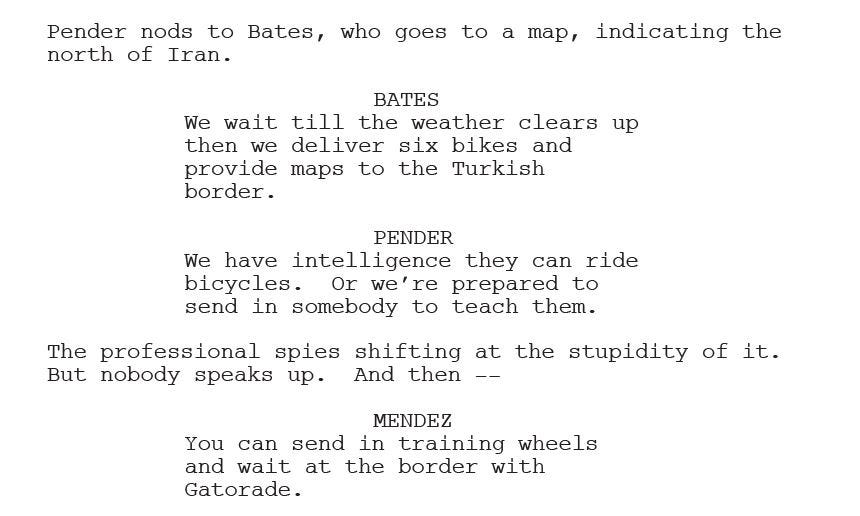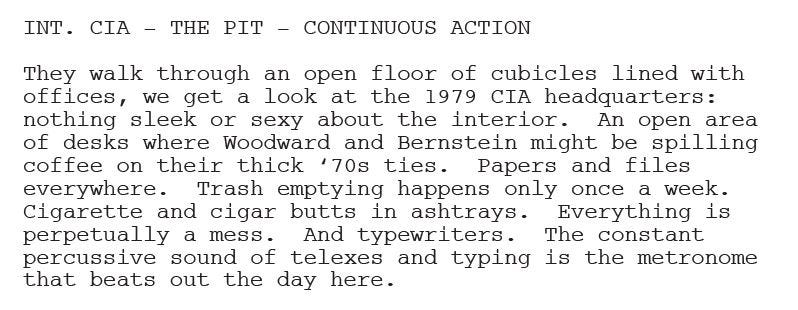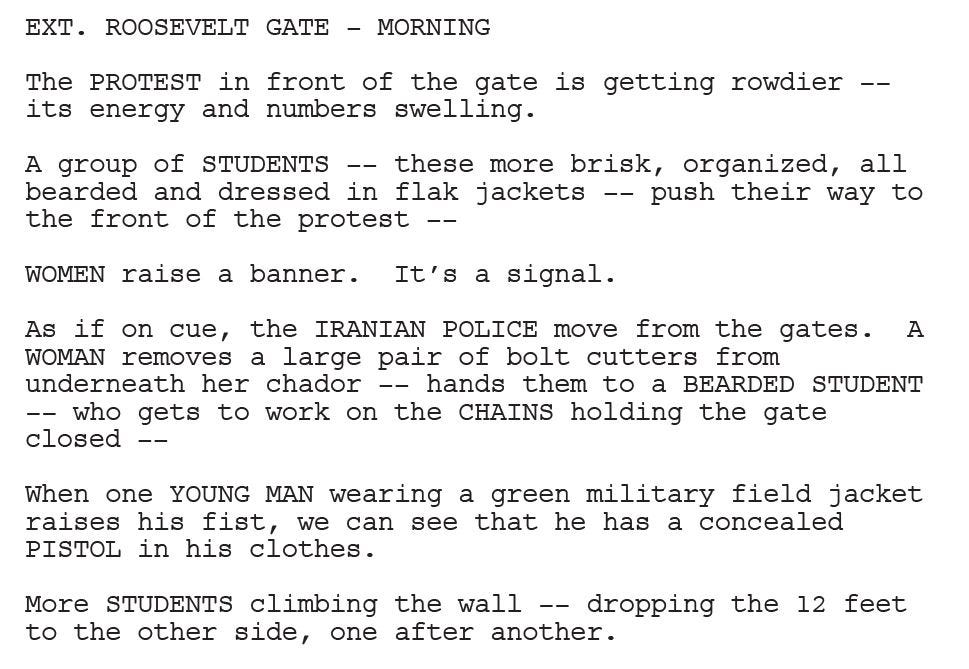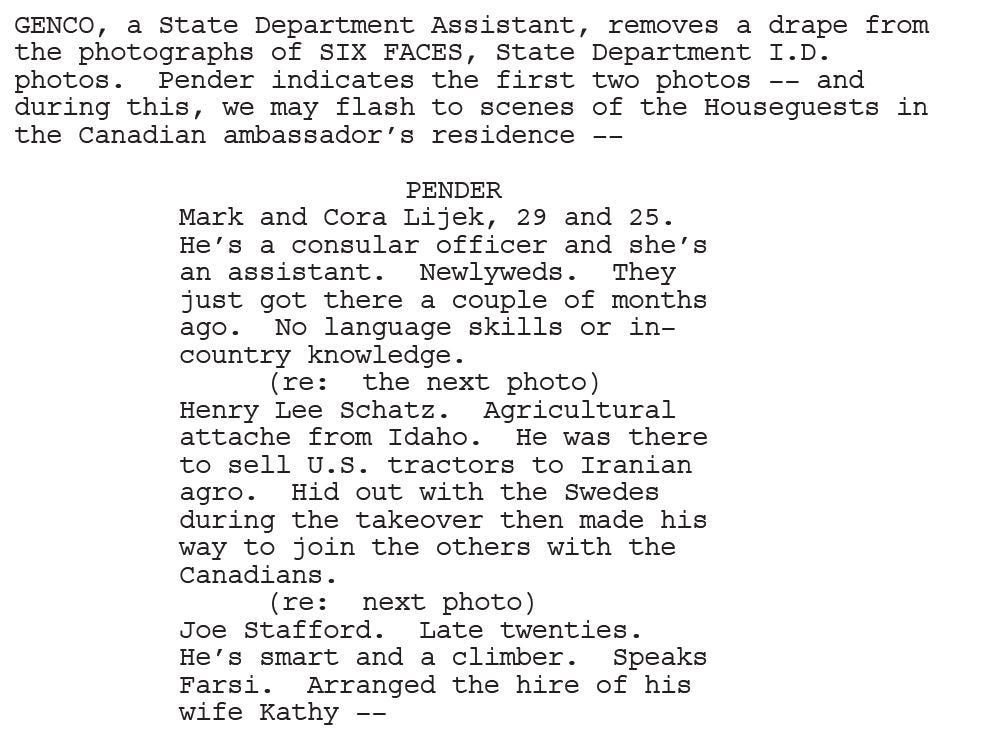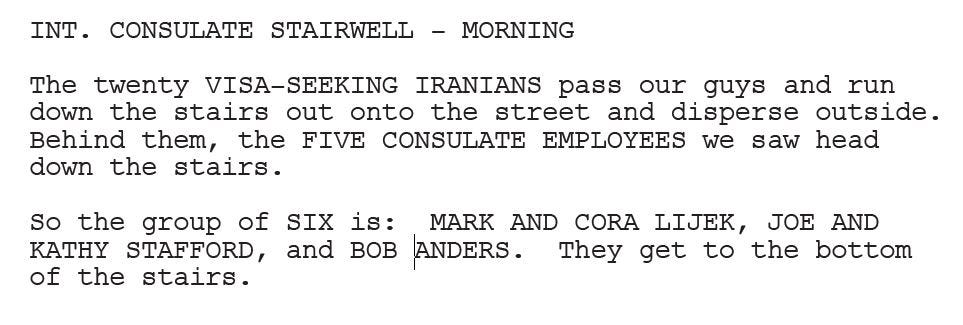Argo (2012) Script Review | #85 WGA 101 Greatest Scripts of the 21st Century
Chris Terrio’s economical yet gripping style turns a stranger-than-fiction real CIA rescue operation during the 1979–1981 Iran hostage crisis into a solid thriller.
Logline: As the Iranian revolution reaches a boiling point, a CIA 'exfiltration' specialist concocts a risky plan to free six Americans who have found shelter at the home of the Canadian ambassador.
Written by: Chris Terrio
Based on: The May 2007 "Wired" magazine article, “The Great Escape” by Joshuah Bearman; and chapter nine of the book entitled “The Master of Disguise” by Antonio Mendez
Pages: 122
Number of scenes: 339
The beauty of the Argo screenplay lies in its execution. Like Eddie Felson at a pool game, the script neatly lines up the elements— character, structure, intention and obstacle, and memorable dialogue—and pockets them all with an effortlessness grace. It has drama, it has suspense, it has history (though a myopic one at that)— and it mixes them altogether to deliver a well-written solid screenplay. It invites less reflection than it inspires fist-pumps over the dramatic retelling of a real rescue operation; perhaps too dramatic, but hey, it’s the movies, not a documentary!
Here's what happened, for real: On November 4, 1979, Iranian protestors stormed the United States Embassy in Tehran in retaliation for President Jimmy Carter offering asylum to the deposed Shah during the Iranian Revolution, a dictator installed by the West. Sixty-six members of the embassy staff were taken as hostages; six evaded capture and found shelter in the home of Canadian Ambassador, Ken Taylor.
Here's also what happened, for real: Fearing what might happen to the six staffers when they get caught by the Iranian government, the U.S. State Department explore options to get them out of there. CIA agent Tony Mendez, an exfiltration specialist, is consulted but he is critical about the proposals on the table. Given that there’s barely any CIA infrastructure in Tehran left, there’s only one to get the escapees out of the country: They’d have to take false identities, most likely Canadian, walk right through Mehrabad Airport, and board a plane. Right under the noses of the Revolutionary Guard. In the meantime, the militants had hired carpet weavers to reassemble shredded embassy records to figure out who was CIA. Time was slowly running out, and Mendez was stuck for a cover to smuggle them out under.
Here’s what happened, for real mixed with some fabrication: Mendez struck upon an idea so audacious it makes you want to do a spit-take— they would disguise themselves as Canadian filmmakers scouting Iran for potential filming locations for a science-fiction film. Recruiting the assistance of veteran Hollywood makeup artist, John Chambers— who happened to be a friend of Mendez’s and had collaborated with the CIA in the past— and a producer, Lester Sigell (a fictional character that was a composite of other people in Hollywood who’d assisted the mission) a fake production company was quickly assembled, the rights to a script were bought, and a cover was assembled. On January 25, 1980, President Carter signed off on the mission, and Mendez slipped into Iran to rescue the six. Three days later, he successfully flew them out.
It’s easy to see the cinematic potential here; it practically writes itself. Its ’70s setting allows it to feel like an homage to touchstones such as All The President’s Men and Three Days of the Condor, but wrapped up in the shiny wrapper giving a peek into both the Hollywood and CIA machine. However, liberties were taken to add tension even if it diverged from the historical record – in reality, the group never faced imminent danger as they do in the script, nor were they almost caught by the komiteh on the runway. But like I said, this is a movie- had it stuck to the real events (where they slipped through the airport without tipping off the guards), the third act might have fallen flat.
Who is Chris Terrio?
Argo was written by Chris Terrio (born December 31, 1976), and was loosely based on a Wired article by Joshuah Bearman titled ‘How the CIA Used a Fake Sci-Fi Flick to Rescue Americans From Tehran,’ as well as The Master of Disguise, the memoir of Tony Mendez. Terrio also supplemented his own research, conducting extensive investigations into minute details to get it right; he pored over archives to ensure that Mendez’s quip on page 19 about Gatorade was accurate for its time and not anachronistic (it wasn’t).
For any story set in the past, attention to detail matters; scratch that, it matters for any screenplay. For Terrio, it paid off; his efforts netted him the Academy Award for Best Adapted Screenplay and the Writers Guild Award in the same category in 2012.
Although Argo brought early fame to Terrio, he was not new to the Hollywood scene. He’d previously made his directorial debut with the 2005 feature film Heights, shortly after graduating with a master’s degree from the USC School of Cinematic Arts. Prior to that, he studied English literature and German phenomenology at Harvard University, and even temporarily enrolled for a MLitt at the University of Cambridge before shifting his energies to the movies. It would also explain why his writing style has a certain elegance and poeticism that you don’t necessarily find in most screenplays unless the writers enjoy reading literature (the Coen brothers and Charlie Kauffman come to mind). But when he does, it’s all in service of describing the action and not being flowery for the sake of showing off.
What is Chris Terrio’s writing style?
If Terrio has a writing style, it’s that he is economical with his lines— for instance, instead of repeating dialogue where a character says something in a different language, he indicates that it’s said in Farsi…
Or if he needs to mention that characters from a previous scene also appear in the next scene, but doesn’t want to list them all out again, he simply mentions that everyone from that scene is present.
Even though it’s a historical piece, Terrio doesn’t shy from making commentaries on the times—describing CCTV monitors as “chunky 1970s monitors” [page 3]…
… commenting on the fewer number of stars on the CIA’s wall [page 14]…
… or describing the fashion sense at the time as “thick ’70s ties” [page 16]…
After all, this is a blueprint that’s meant to guide the reader’s eye and understand what needs to be created by the production designer and crew. The lesson being: Don’t be afraid to make commentaries to orient the reader as to what you want them to see.
Humor also matters! It leads to a lot of memorable lines, largely courtesy of Leslie Siegel, including the iconic “Argo fuck yourself.”
Additionally, Terrio uses a lot of double hyphens ‘- -’ to either indicate a new shot or breaking paragraphs to create urgency.
He also keeps in mind to be visual especially since this is an exposition-heavy script, such as by breaking the monotony on page 18 by inserting a comment on how to insert cutaways to what is happening without going into extensive detail.
Terrio commits one cardinal sin in his screenplay, and that’s using the tired trope of the call to prayer to let us know that we are somewhere in the Middle East. Don’t. Just… don’t.
Who are the characters in Argo?
Tony Mendez – “40, asleep in his clothes from the day before.”
Jack O’Donnell
John Chambers – “Hollywood’s first Oscar winner for makeup.”
Lester Siegel – “a semi-legendary producer in his semi-legendary seventies. He’s equal parts bookie and rabbi.”
Ken Taylor – “40s, Canadian ambassador. He does much to support the myth that Canadians are always in a good mood.”
Pat Taylor – “Filipino, 40s.”
Mark Lijek – “29, a consular officer”
Cora Lijek
Joe Stafford
Kathy Stafford
Bob Anders – “late 40s-50s, a consular officer”
Sahar
What are the key takeaways to learn from the Argo screenplay?
Three key takeaways worth mentioning to think about when writing your own screenplays:
Although we meet the six escapees in the opening pages, it’s only on page 9 that Terrio explicitly identifies them, which is a good way to help reiterate that these are going to be the focus of the script.
The real character arcs belong to the six escapees, who must overcome their fear of being caught and executed by the Revolutionary Guard to escape Tehran. In comparison, Tony Mendez is a relatively static character- he responds to obstacles and adversity with ingenuity and courage, but he doesn’t really change from the person he is when the story starts. The only change is that his close call with death prompts him to go and see his estranged wife and son. Your protagonist can be static, so long as the supporting characters undergo a change; even then, offer a small change for your protagonist that feels personal.
The protagonist, Tony Mendez, doesn’t get introduced until page 14! But that’s because everything up until then sets up the situation and the stakes in order for our protagonist to dive straight in without having to play catch up. This is an excellent template if you have a static protagonist—you can delay their introduction and use that time to establish: a) the stake characters; b) the environment where it’s going to take place. But then remember to get your protagonist into action ASAP!
Terrio doesn’t waste a lot of time describing his characters beyond their age, and, if required, their ethnicity. But I like how he describes Mendez through his clothes, showing us that his work consumes his life so much that he doesn’t even have time to sleep properly (and later, we get the hints that his work-life has strained his personal life). This is a great example of show, don’t tell.
I’ll be honest, my favorite adapted screenplay from 2012 is one that isn’t featured on the WGA’s list of greatest screenplays of the 21st century: Lincoln, written by Tony Kushner. But that doesn’t mean Argo is bad in anyway. In fact, there is plenty to learn by studying Chris Terrio’s screenplay: how to build tension, how to structure it in an organic manner, the importance of research, writing some good quips, and how to write a historical drama that grabs you and doesn’t let go until the final page. Especially when you’re starting out, what more can you ask for in a screenplay?
Notes:
https://www.vulture.com/2012/12/toughest-scene-i-wrote-chris-terrio-on-argo.html


